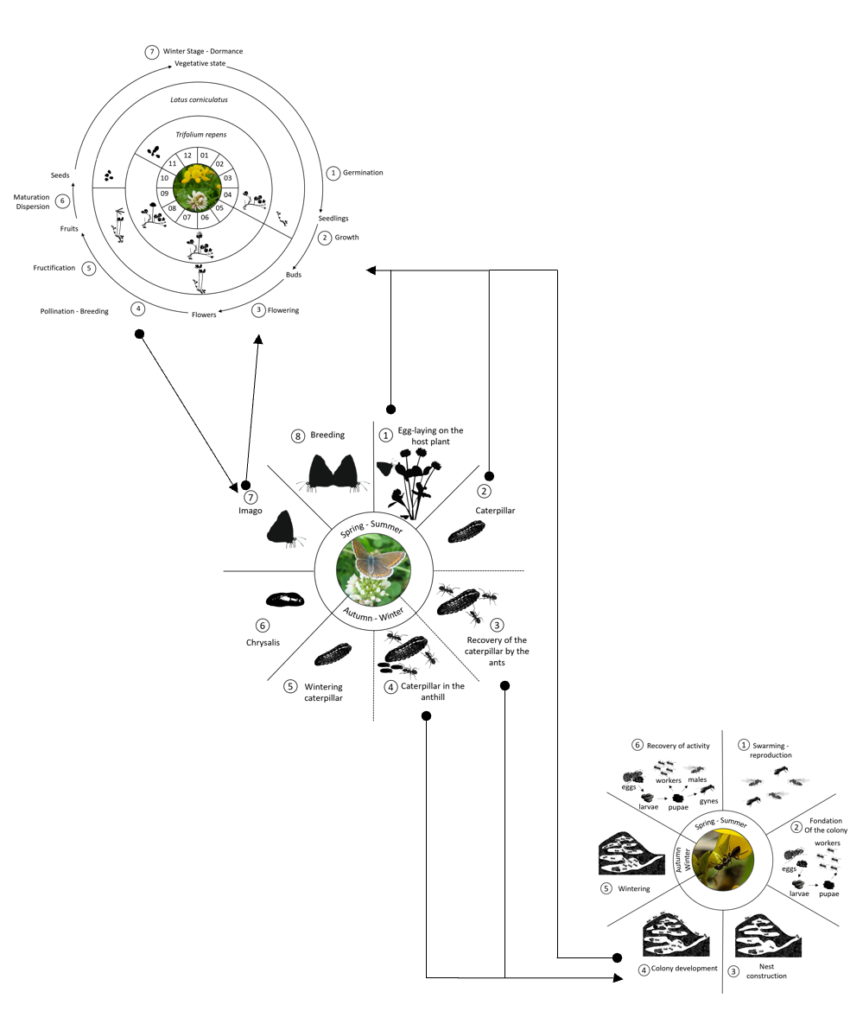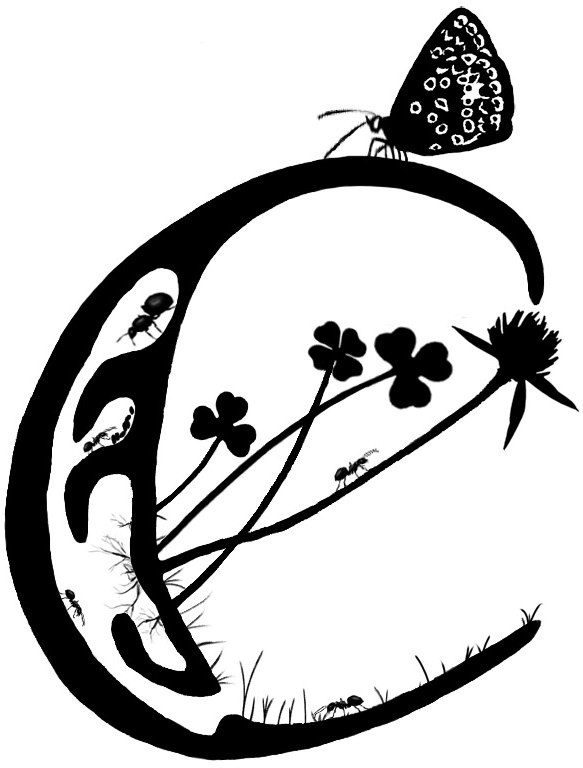The biological material studied was selected according to the following criteria:
1) very common and abundant species in France;
2) butterfly species of the Lycaenidae Family with a large number of species with a life cycle in relation to ants (Bellmann, 2006); ant species in relation to the butterfly Polyommatus icarus in its life cycle; host plant species of Angiosperm (flowering plant), perennial plants favored by Polyommatus icarus among leguminous, Fabaceae, Papillonaceae (Bellman, 2006; Lewington & Tolman, 2014 ; Carter & Hargreaves, 2015 ; Martiré et al., 2016 ; Haahtela et al., 2017) ;
3) easy breeding species under controlled conditions, species that can develop in the available laboratory space, plants up to 50 cm high;
4) potentially sensitive to climate change;
5) known general biology.
The selected species are therefore:
- Butterfly: Polyommatus icarus,
- Ants: Lasius niger,
- Host plants: Trifolium repens, Lotus corniculatus.
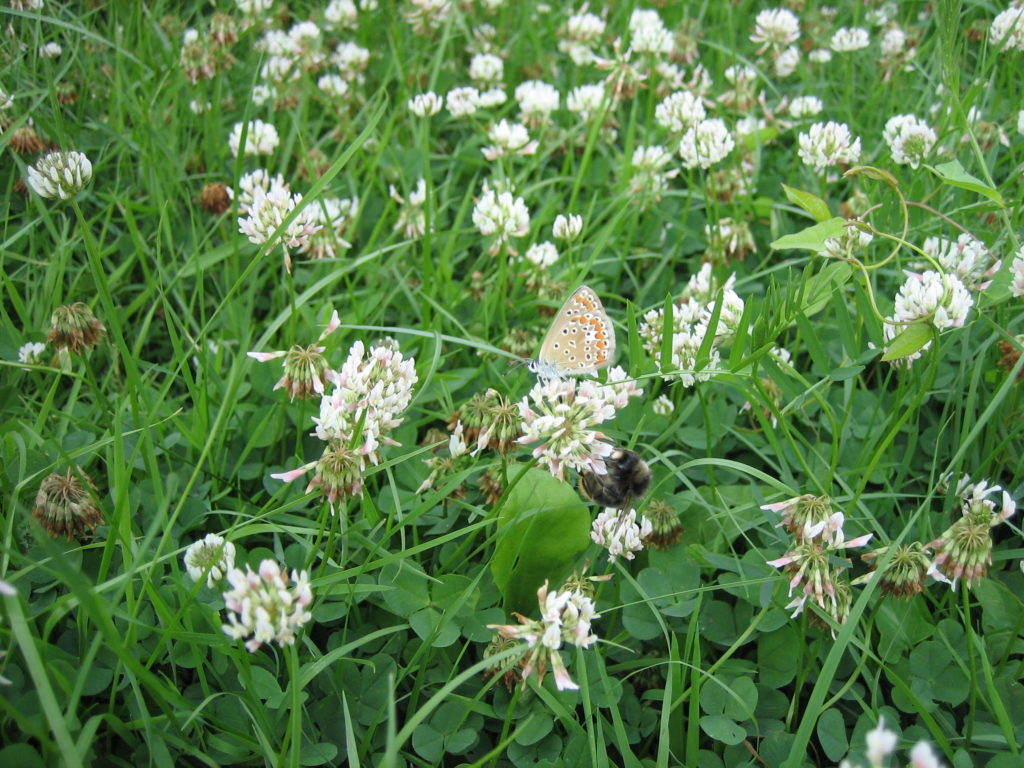
Biology and ecology of the Common Blue butterfly Polyommatus icarus (Rottemburg, 1775) (Lepidoptera, Lycaenidae)
Latin name : Polyommatus icarus (Rottemburg, 1775)
Vernacular names: Common Blue
Taxonomy: Kingdom: Animalia, Phylum: Arthropoda, Class: Insecta, Order: Lepidoptera, Family: Lycaenidae, Genus: Polyommatus, Species: Polyommatus icarus
Species identification :
- Imago identification
Upperside of wings: marked sexual dimorphism; blue-purple with a thin black border for the male; brown to orange close to margin on anterior and posterior wings for female (Hofmann, 2007 ; Lewington & Tolman, 2014 ; Martiré et al., 2016)
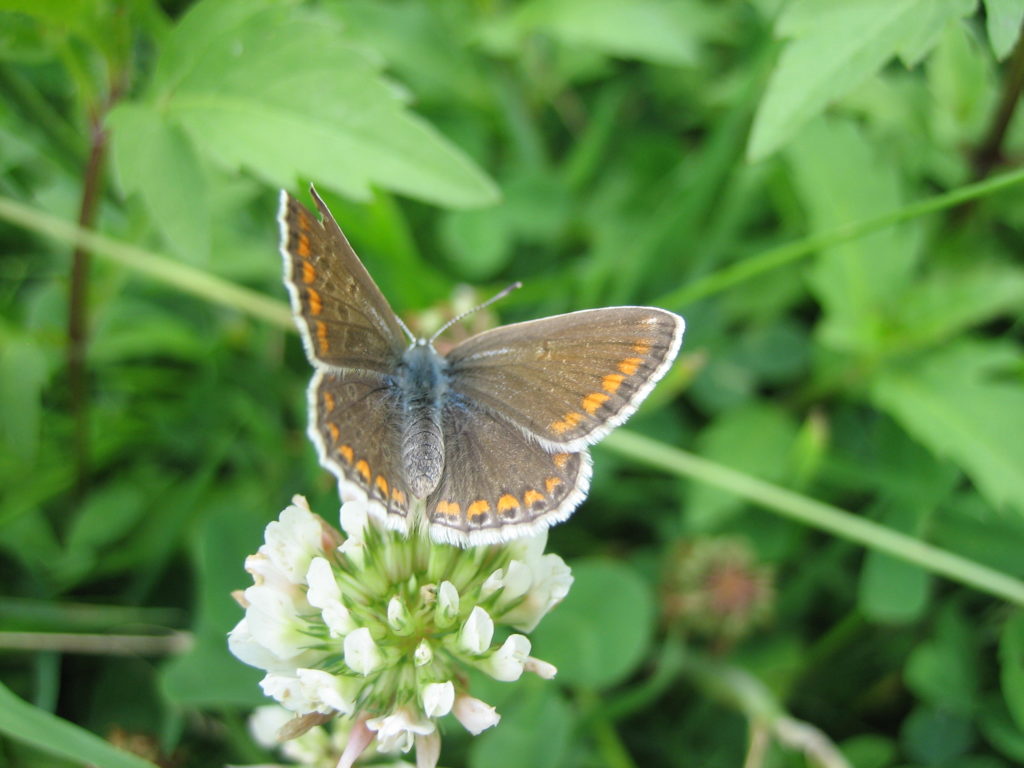
Underside of the wings: light brown, black dots circled in white, line of orange lunules near the margin, white fringes; forewing at 1 or 2 cell points; posterior wing with a white triangle, postdiscal line of regular black dots (Lewington & Tolman, 2014 ; Martiré et al., 2016)
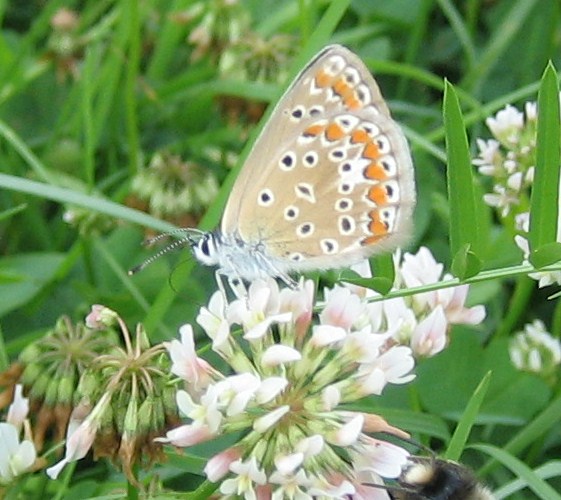
Wingspan: 2.7 cm to 3.4 cm (Hofmann, 2007)
- Caterpillar identification
13 mm in length (Bellmann, 2006), stocky, green with dark green dorsal line and whitish line on the flanks (Carter & Hargreaves, 2015)
Geographic distribution: Very common in France and Europe (Lewington & Tolman, 2014 ; Carter & Hargreaves, 2015 ; Martiré et al., 2016 ; Haahtela et al., 2017)
Biotope: Diversity of habitats from open to semi-shaded natural environment, dry to mesophilic from sea-level up to 3000 m altitude (dunes, wastelands, meadows, roadsides, agricultural areas, gardens in the city, … ) (Hofmann, 2007 ; Leraut, 2003 ; Lewington & Tolman, 2014 ; Carter & Hargreaves, 2015 ; Martiré et al., 2016 ; Haahtela et al., 2017)
Life cycle:
Polyommatus icarus is a polyvoltine species that is to say that it presents several successive generations each year.
Voltinism of this species is related to altitude and latitude: univoltine, June / July in cold climate in northern Europe and at altitude in mountain, bivoltin to trivoltin May / early October in most of the Europe, trivoltin at the level of the sea, in the south of Europe, in the canaries, it is observed every month (Lewington & Tolman, 2014 ; Martiré et al., 2016).
The life cycle of Polyommatus icarus is divided into 8 stages including the four stages of metamorphosis of butterfly: egg, caterpillar, chrysalis and imago.
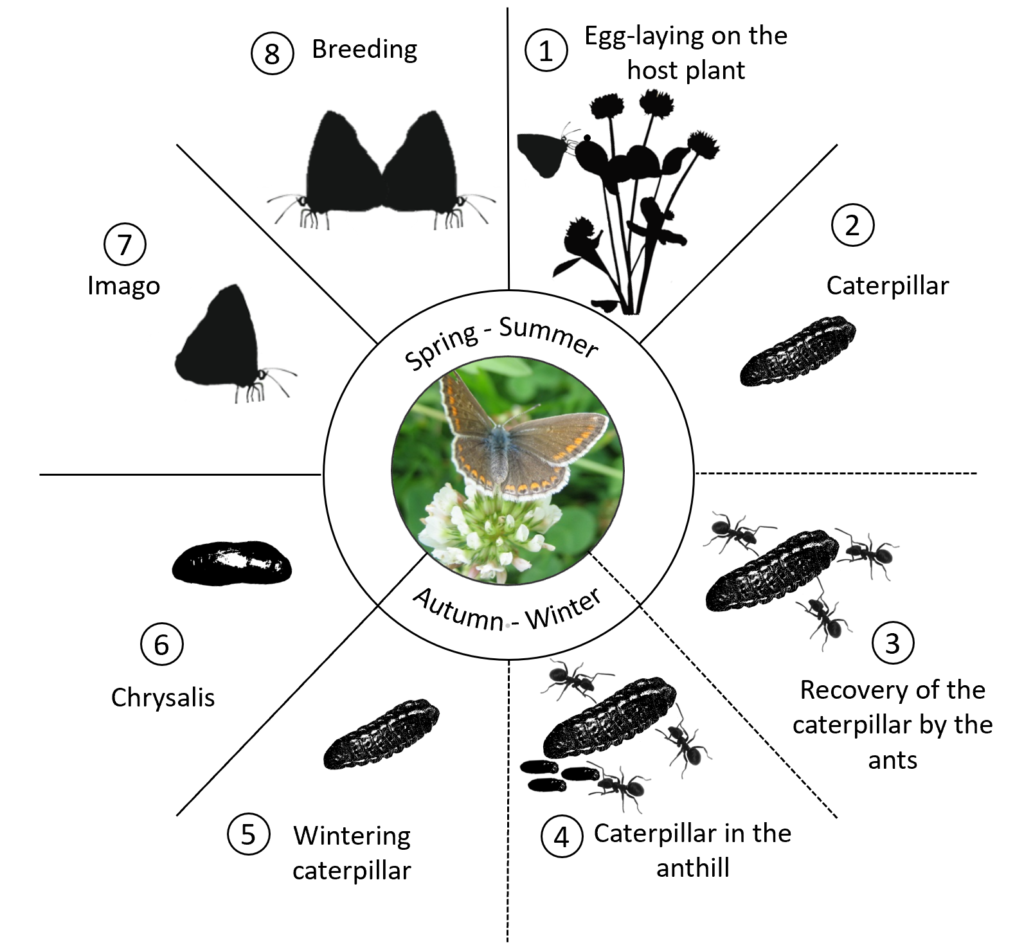
Stage 1. Egg-laying on the host plant
The female lays whitish and hemispherical eggs, arranged in isolation from each other, on the flowers, stems and upper surface of the leaves of the host plants at the beginning and end of summer. (Carter & Hargreaves, 2015) The host plants are legumes (Fabaceae) exclusively Papilionaceae mainly Lotus corniculus (Bellman, 2006; Lewington & Tolman, 2014), Medicago lupulina (Lewington & Tolman, 2014) but also Trifolium repens, Onoris spinosa, Medicago sativa, (Bellman, 2006), and various Galega sp.), Lotus sp., Medicago sp., Trifolium sp., Melilotus sp. Gesnista sp., Astragalus sp., Onobrychis sp., Anthyllis sp., Coronilla sp. (Bellman, 2006; Lewington & Tolman, 2014 ; Carter & Hargreaves, 2015 ; Martiré et al., 2016 ; Haahtela et al., 2017).
Stage 2. Caterpillar stage
Eggs hatch in a caterpillar after one week during the period May to early October (Bellmann, 2006; Carter & Hargreaves, 2015). During this stage which lasts about 6 weeks (Carter & Hargreaves, 2015), there is a considerable increase in the volume of the caterpillar punctuated by completion of several moults. It feeds mainly on leaves and flowers of the host plants. The caterpillar’s head is strongly sclerified with six simple eyes called stemmates and a rudimentary antenna in the center of chewing mouthparts. The caterpillar has a fairly regular trunk consisting of fourteen segments or urites, the first of which have pairs of articulated legs and the latter merge to form a single anal segment (Bellmann, 2006).
Etape n°3. Recovery of the caterpillar by the ants
Polyommatus icarus is a myrmecophilous species, that is, it is an optional association with ant species that will protect caterpillars occasionally (Pierce et al., 2002). The caterpillar secreted by Newcomer’s dorsal gland a sweet liquid (sucrose, glucose, fructose and amino acids) appreciated by ants and by defensive glands a substance inhibiting the aggressiveness of ants (Martiré et al., 2016).
Stage 4. Caterpillar in the anthill
The ants then take the caterpillar into their anthill. The caterpillar will be protected from pests, predators and cared by ants from Lasius alienus, Lasius flavus, Lasius niger, Formica subrufa, Formica cinerea, Plagiolepis pygmaea, Myrmica sabuleti, Myrmica lobicornis) (Lafranchis & Kan, 2012; Lewington & Tolman, 2014). Lasius is the kind of ant that most associates with Lepidoptera Lycaenidae (Martinez, 2013). In the anthill, the caterpillar consumes some eggs and ant larvae. In exchange, it provides a honeydew (a liquid mixture of sugars and amino acids) for ants (Pierce et al., 2002 ; Martiré et al., 2016).
Stage 5. Wintering caterpillar
Tracks of the latest generation hibernate regardless of their state of growth in undergrowth among dead leaves and plant debris (Bellmann, 2006; Carter & Hargreaves, 2015).
Stage 6. Pupal stage
At the end of its development, the caterpillar becomes a chrysalis or nymph. Pupation corresponds to profound internal evolutions of transformation of larval tissues into imaginal tissues (Bellmann, 2006) and takes place at the base of the host plant for about two weeks in the spring-summer (Carter & Hargreaves, 2015). Nymphs have shapes and colors that allow them to hide predators among plants (Bellmann, 2006).
Stage 7. Imago stage
The imago (adult butterfly) comes out of the chrysalis after a few days. The last generation caterpillars complete their imago development the following spring. The imago has a body called an exoskeleton consisting of a head with eyes, antennae (olfactory and tactile organs) and a maxillary trunk to suck the nectar of several plant species of Papilionaceae; a thorax with six legs, four membranous wings covered with scales; and an abdomen with reproductive organs and odoriferous organs that produce pheromones (Bellmann, 2006).
Stage 8. Breeding
Imagos fly between the end of March and November (Hofmann, 2007 ; Carter & Hargreaves, 2015 ; Haahtela et al., 2017). During this period, adults meet through pheromones (substances of sexual attraction) secreted by unfertilized females and olfactory organs of males. Males catch pheromones for miles and secrete pheromones to mate. Polyommatus icarus is characterized by the high fertility of females (Bellmann, 2006). The imagos live a few weeks to a few months.
At each stage of the life cycle, butterflies are exposed to various predators: mammals, insectivorous birds (eg tits), amphibians, spiders (eg spiders-crabs), insects (eg wasps, hornets) (Bellmann, 2006).
Biology and ecology of the Small Black Ant Lasius niger (Linnaeus, 1758) (Hymenoptera, Formicidae)
Latin name : Lasius niger (Linnaeus, 1758)
Vernacular names : Small Black Ant
Taxonomy: Kingdom: Animalia, Phylum: Arthropoda, Class: Insecta, Order: Hymenoptera, Family: Formicidae, Genus: Lasius, Species: Lasius niger
Species identification
Dark brown to black-brown in color, covered with dense silver seta with longer isolated seta, pubescence on dense clypeus (Blatrix et al., 2013 ; Bellmann, 2016)
Ants are social insects organized into castes: fertile female queen measuring 8 to 9 mm; Males whose only function is to fertilize future queens 3,5-4,5 mm; Sterile female workers 2.5-5 mm (Blatrix et al., 2013 ; Martinez, 2013; Bellmann, 2016)
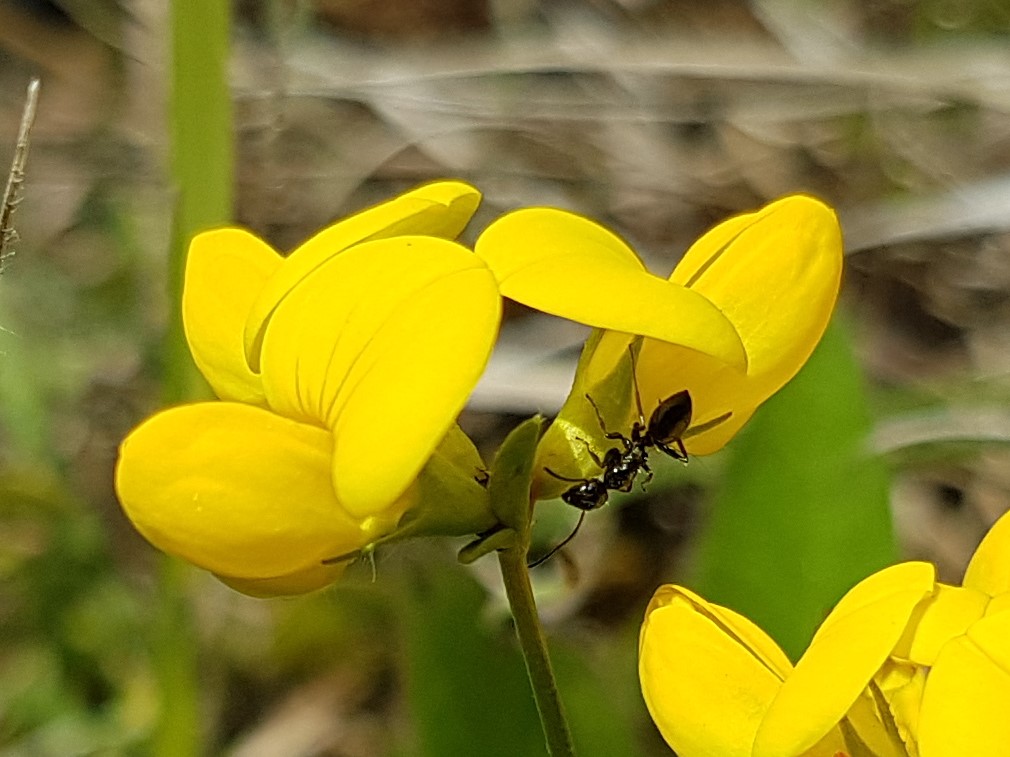
Geographical distribution: very common in Europe except in the Mediterranean region(Blatrix et al., 2013 ; Bellmann, 2016)
Biotope: Diversity of rather humid habitats up to 1500 m altitude (meadows, forest edges, various anthropised environments, agricultural areas, urban gardens,…) (Blatrix et al., 2013 ; Bellmann, 2016)
Life cycle of Lasius niger colony
Lasius niger is a monogynous species, that is to say that the colony has only one queen. The colony is also made up of thousands of workers (Blatrix et al., 2013). The life cycle of the colony of Lasius niger is divided into 5 stages including the four stages of development of the ant: egg, larva, nymph, adult (queens, males, workers).
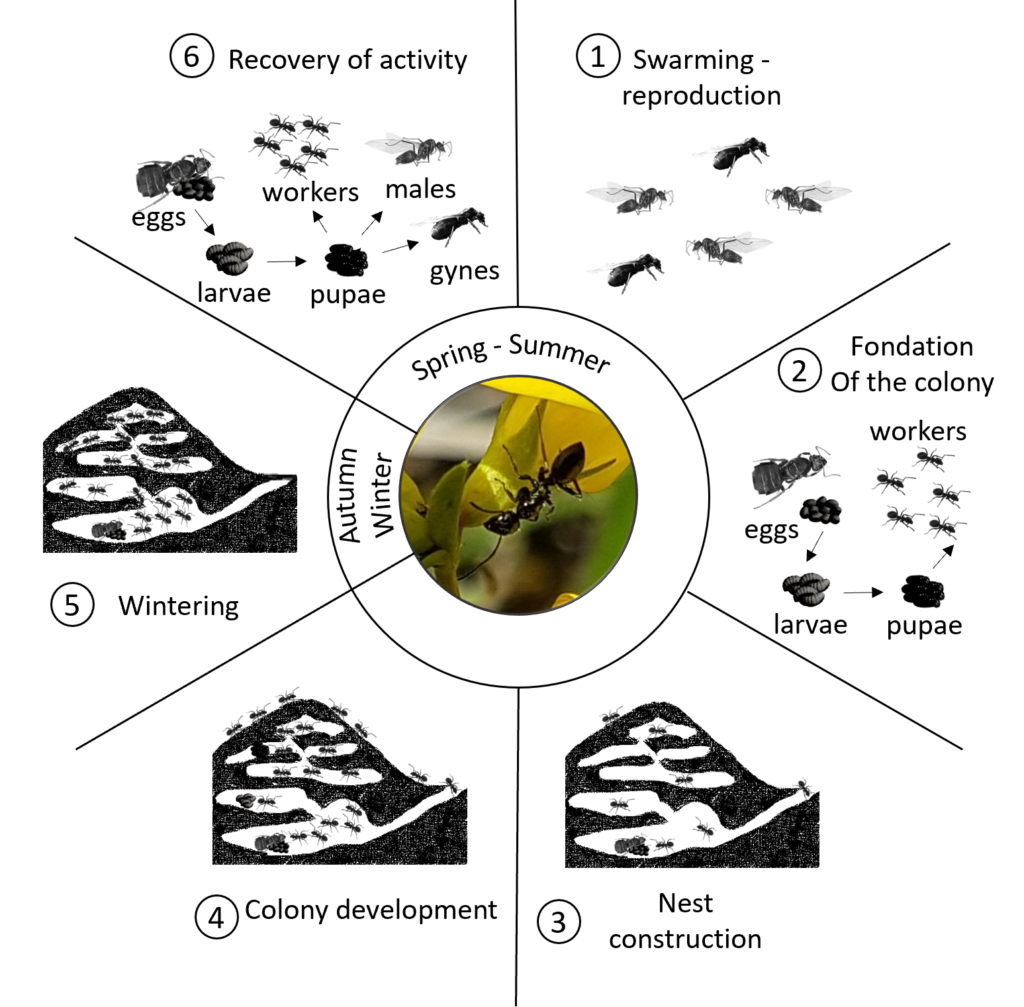
Stage 1. Swarming – Breeding
Swarming is the period of nuptial flight of sexed males and females (princesses) that breed from June to September. Swarming is abundant in the second half of June. Females are fertilized by males and store spermatozoa for the rest of their lives. These females become queens then tear off their wings and look for a dark, wet and quiet place to begin the foundation of a new colony (Martinez, 2013; Bellmann, 2016). The queen has a life of about 20 years with a record 28 years in captivity (Martinez, 2013). After mating, the males die quickly.
Stage 2. Foundation of the colony
The queen lays the first eggs that hatch after about ten days. These first larvae are fed by the queen by trophallaxie that is to say by regurgitation of pre-digested food. The trophallactic food comes from the body reserves of the queen by metabolizing its reserves of fat and the muscles of its wings. The seta of larvae facilitate their transport then form a cocoon to the support where they are and become after a few tens of days molting nymphs. Nymphs do not feed. In September, the nymphs give first very small and white workers who quickly become dark (Matinez, 2013). These first workers leave the nest to look for food (honeydew aphids, dead insects and nectar plant, Martinez, 2013) to feed the queen with trophallaxia and take over the foundation of the colony. The queen then devotes herself exclusively to her reproductive function.
Stage 3. Nest construction
The nests are built in the ground, under the stones, or under the bark of the trees leading to the surface with a simple hole and consisting of a small dome of earth and fragile mineral particles dug of many galleries. Nests can also be found in urban areas under stones, flowerpots, between sidewalk slabs (Bellmann, 2016). Their nest can have a rather variable appearance with generally elongated galleries. The environmental conditions necessary for the nest are as follows: permanent moisture not excessive, not too hot, ventilated, quiet and obscure place. If the humidity is too low the queen, eggs and larvae can be dried and die. On the contrary, excess water in the galleries can cause death by drowning ants (Martinez, 2013).
Stage 4. Colony development
The young colonies spend their time in their nest. The colony that will have the most workers will survive. After its foundation, the colony develops at an accelerated rate: at the end of the first autumn a few tens, at the end of the second few hundreds and at the end of the third thousands (Martinez, 2013). Older and tallest workers look for food on the floor and plants for the colony. The diet of this species is omnivorous (Blatrix et al., 2013; Martinez, 2013). This species looks for aphid honeydew on trees, shrubs and grasses (Blatrix et al., 2013 ; Bellmann, 2016). It protects the colonies of aphids and mealybugs (Blatrix et al., 2013). The youngest workers are in charge of the maintenance of the eggs, the feeding of the larvae and the cleaning of the colony. The workers have a life of 1 to 3 years (Martinez, 2013).
Stage 5. Wintering
Lasius niger is an endogenous heterodynamic species that is to say that it has an obligatory stage of dormancy or winter diapause obligatory in its cycle. The cessation of laying, brood growth, and colony activity are done according to the internal clock of the colony from mid-October to March. At this stage, there are no more eggs, the larvae winter and pupate the following spring (Martinez, 2013).
Stage 6. Resumption of activity
In the following spring, the queen resumes her nesting activity. Eggs of white color and ellipsoid shape develop into vermiform larvae with tapered body and arched forward (Bellmann, 2016). The larvae then become nymphs. This stage is defined by profound internal transformations: digestive tract, nervous system, sense organs, respiratory system, musculature. Nymphs give: males for unfertilized eggs; females for the fertilized eggs that will be either future queens or sterile workers depending on the type of food they have received in the larval state (Martinez, 2013).
At each stage of the life cycle, ants are exposed to various predators: birds, lizards, insects, spiders and other ants.
Biology and ecology of host plants of Polyommatus icarus butterfly : Lotus corniculatus (Linnaeus, 1753), Trifolium repens (Linnaeus, 1753) (Fabale, Fabaceae)
Latin name :
- Lotus corniculatus (Linnaeus, 1753)
- Trifolium repens (Linnaeus, 1753)
Vernacular names :
- Common Bird’s-foot-trefoil
- White Clover
Taxonomy: Kingdom: Plantae, Class: Equisetopsida, Order: Fabales, Family: Fabaceae (Family formerly called leguminous), Genus: Trifolium, Lotus, Subfamily: Papilionoideae, Species: Lotus corniculatus, Trifolium repens
Species identification
Perennial, creeping plants 5 to 50 cm high (Bellmann, 2006 ; Mac Clintock et al., 2005 ; Fletcher et Eyssartier, 2008)
1) Lotus corniculatus
Plant from 5 to 30 cm tall; Long and taproot; Stem little branched; Leaves composed of 5 ovoid to lanceolate leaflets, shortly petiolate; Flowers 1 to 1.6 cm, bright yellow, often with red on the outside, grouped by 2 to 7 in umbellate capitulum, flowering from May to September; Floral peduncle longer than leaves; Fruits in linear pods 2 to 3 cm long, slightly thicker than 4 mm (Bellmann, 2006 ; Mac Clintock et al., 2005 ; Fletcher et Eyssartier, 2008)
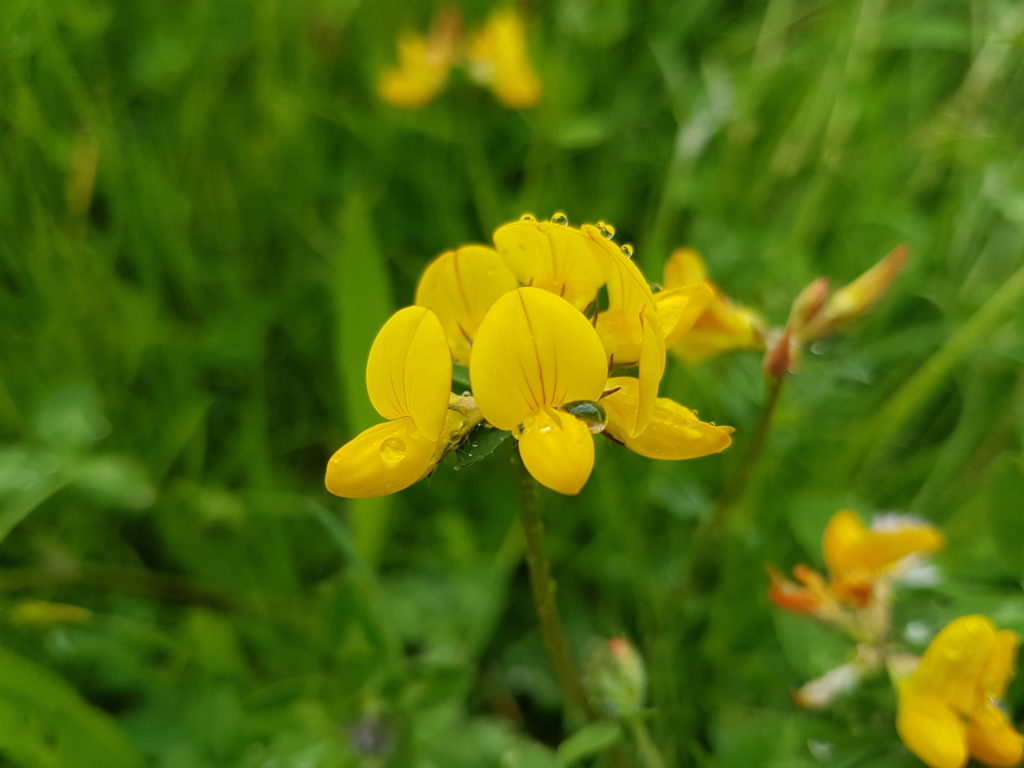
2) Trifolium repens
Plant from 5 to 20 cm tall; Glabrous stem, branching, up to 50 cm long; alternate leaves, more or less long petiolate, petiole up to 20 cm long, trifoliate; Leaflets greater than 10 mm long oval, denticulate at the margin, with a white chevron pattern; Flowers white or pink 7 to 10 mm in number of 20 to 100 flowers per inflorescence, grouped in capitula 25 mm in diameter, flowering from May to October; Floral peduncle exceeding 30 cm in length; Sessile pods of 3 to 4 seeds heart-shaped, yellow to brown in color and about 1.6 mm by 1 mm with an average weight of 0.66 g (Bellmann, 2006 ; Laberche, 1999; Mac Clintock et al., 2005 ; Fletcher et Eyssartier, 2008)
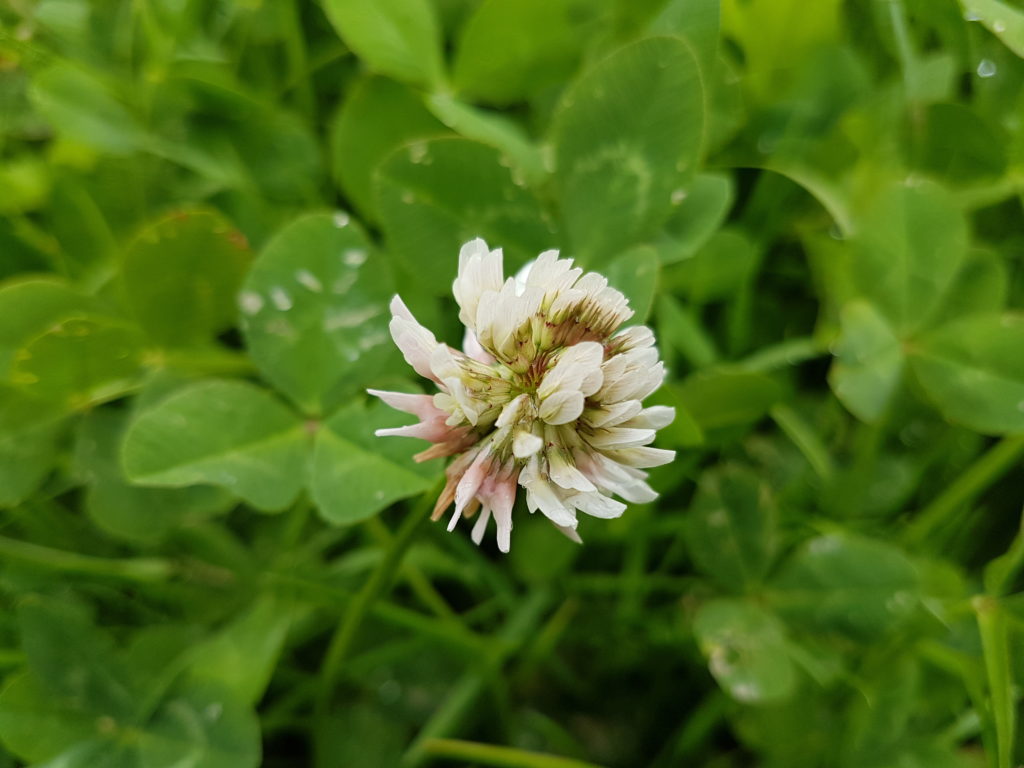
Geographical distribution
Widespread and very common species in France and Europe (Bellmann, 2006 ; Mac Clintock et al., 2005 ; Fletcher et Eyssartier, 2008) almost everywhere and for Lotus corniculatus close to 3000 m altitude in the mountains (Bellmann, 2006 ; Fletcher et Eyssartier, 2008)
Biotope
Grassy areas, wastelands, fields, pastures, lawns, roadside, urban lawns (Bellmann, 2006 ; Mac Clintock et al., 2005 ; Fletcher et Eyssartier, 2008)
Life cycle
The stages of the life cycle of flowering plants outside vegetative propagation are: germination, vegetative growth, flowering, pollination, fruiting, dispersal and the dormancy stage. The plants studied are perennial species, that is to say that their life cycle is spread over several years greater than two years (Laberche, 1999). They are also species of the family of legumes which includes a large variety of plant species cultivated.
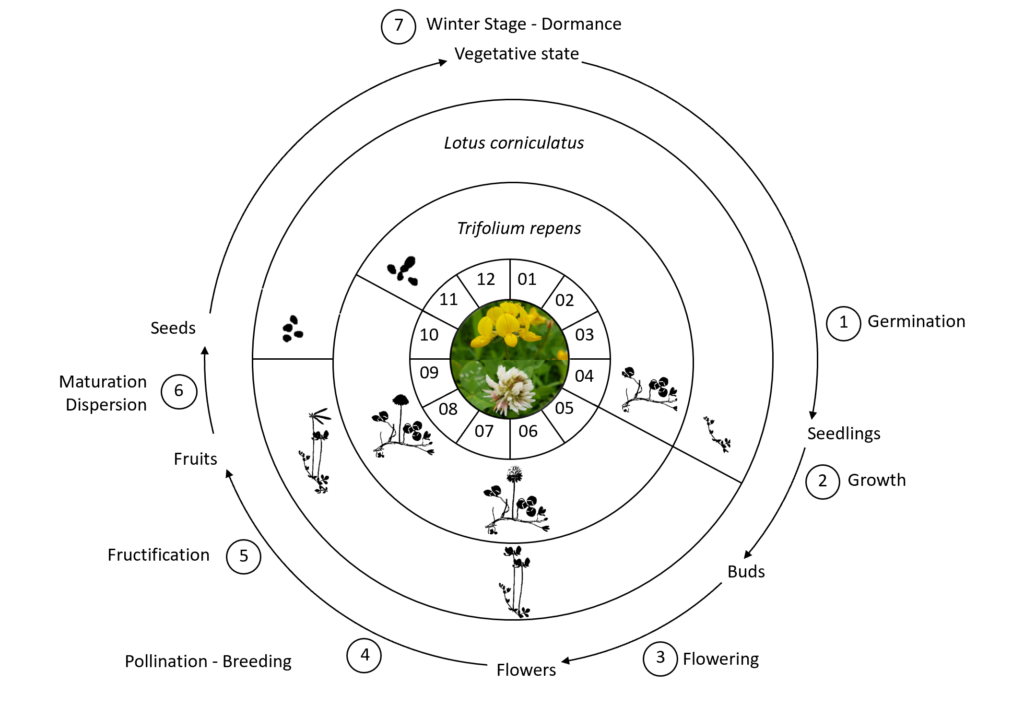
Stage 1. Germination
The seed is a part of the fruit that contains the embryo with the vegetative organs of the young plant, that is to say the radicle that will give the root, the future tigelle the stem and the gemmule a draft of the terminal bud (Heller et al.,1995).
The seed passes from latent life to germination if the favorable external and internal conditions are favorable: water, oxygen, temperature, luminosity, duration of the day; mature seed with accumulation of reserves and dehydrated, longevity of seeds. Germination results in the emergence of the germ that pierces the seed coat. The beginning of the growth of the future seedling is made possible by the use of the nutritive reserves contained in the seed (Heller et al.,1995 ; Laberche, 1999 ; Ozenda, 2000). The germination ends in a few days when all the reserves of the seed have been consumed and photosynthesis took over to ensure the supply of the seedling become autonomous (Heller et al.,1995).
Stage 2. Growth of vegetative apparatus
The development of seedling into adult plant is characterized by root growth, stem elongation and leaf growth. (Heller et al.,1995). Unlike most animal species, plants grow indefinitely during their life cycle. Perennial plants have the particularity of having a discontinuous growth. The emergence of new stems and new leafy twigs is achieved each year by bud burst. The buds are located at the apex of the stems and twigs or at leaves axils. Vegetative buds ensure the development of stems, vegetative branches, and leaves, and flower buds flowering twigs and flowers (Heller et al.,1995 ; Ozenda, 2000). To achieve this growth, plants need water, minerals absorbed by the roots and carbon dioxide through the process of photosynthesis (Laberche, 1999).
Stage 3. Flowering
Flowering is a complex phenomenon linked to many internal and external factors. The flowers form in the buds which pass from the vegetative state to the reproductive state. Flowering is synchronized with the seasons. Each plant species forms its flowers at a particular time of the year determined by the climatic conditions (temperature, brightness and precipitation) (Heller et al.,1995). In perennial plants, the vast majority of species flower every year (Laberche, 1999). The blossoming of flower is accompanied by the dehiscence of anthers that is to say the rupture of the pollen sacs and pollen shed (Heller et al.,1995).
Stage 4. Pollination – breeding
The flower is formed by stamens (male organ of fertilization) and pistil (female organ of fertilization). During the pollination phase, the pollen grains produced by the stamens are transported in a latent state of life by different vectors (the wind called anemogamous, the water called hydrogamy, animals called zoogamy) to the pistil of another plant containing the ovum enclosed in an ovary. In the plant species studied, pollinating insects, such as butterflies, are dispersial vectors of pollen grains. This pollination is called entomophilous. Butterflies feeding on nectar carry from plant to plant the pollen that clings to their bodies. If the pollen grain during its transport meets the stigma of an ovary and if there is genetic compatibility between the two organs and the conditions are favorable (humidity, temperature, brightness) then the fertilization process begin. The pollen grain hydrates and leaves its latent life and germinates in a pollen tube that reaches the embryonic sac allowing fertilization. Angiosperms are characterized by double fertilization. The diploid egg will give the new embryo, the other triploid will form reserve substances necessary for germination (Heller et al.,1995 ; Laberche, 1999 ; Ozenda, 2000).
Stage 5. Fructification
When fruiting, the flower fades and the fertilized egg turns into seed and the ovary into fruit (Heller et al.,1995 ; Laberche, 1999 ; Ozenda, 2000). Legumes have dried fruits in pods (Heller et al.,1995 ; Ozenda, 2000). The stages of the formation and the life of the fruit are the following: a pre-anthesis stage corresponding to a cell multiplication, anthesis characterized by the stop of tissues growth, a period of growth and finally the maturation followed by the fruit senescence (Heller et al.,1995).
Stage 6. Maturation – Dispersion
After a few weeks or months, the fruit ripens and projectig seeds. In Trifolium repens, 3-4 weeks are required between fertilization and seed formation. The methods of seed dispersal are as follows: the plant itself (autochory), wind (anemochory), water (hydrochory), animals (zoochory). Legumes use the plant’s dispersal mechanism called autochoria. The pods are so-called dry fruits dehiscent, that is to say, opening at maturity by slits to release seeds (Ozenda, 2000). Seeds in contact with the soil can then germinate to form new plants (Heller et al.,1995 ; Laberche, 1999 ; Ozenda, 2000).
Stage 7. Winter dormancy stage – vegetative state
Perennial plants spend the winter in life slowed as underground reserve organs with some leaves. Trifolium repens survives by its buried stump (Laberche, 1999). Seeds that have not germinated are also dormant in the winter season. Latent life corresponds to reduced cell activities allow plants to resist adverse conditions. The breathing and the release of heat are reduced. Nutritional exchanges, synthesis and growth are stopped. The upper part of the perennial plant species is then renewed each year and produces new seeds for several years. Dormant seeds return to active life and germinate the following year when external conditions are favorable (Heller et al.,1995 ; Laberche, 1999).
Relationships between the biological cycles of Polyommatus icarus with Lasius niger, Lotus corniculatus and Trifolium repens
The life cycle of Polyommatus icarus is dependent on the life cycle of its host plants including Lotus corniculatus and Trifolium repens. Egg-laying of P. icarus (stage No. 1 P. icarus) is done on adult host plants (at the end of their growth stage No. 2 host plants). The egg hatches in caterpillar (stage n ° 2 P. icarus) whose survival is ensured exclusively on its host plants which it will feed. Following the development of caterpillar into chrysalis then into imago (stage No. 6 and 7 P. icarus), these nectariferous plants (stage No. 3 host plants) are also an important food source for adult butterflies that will be able to reproduce (stage No. 8 P. icarus). By going from flowers to flowers, butterflies pollinate its host plants which will in turn be able to reproduce (stage 4 of the host plants).
An optional association can be made between Polyommatus icarus and ant species as Lasius niger. At Stage 2 of the life cycle of P. icarus, the caterpillar attracts the ants that will bring it to the nest (stageNo. 3 P. icarus) and protect it from parasites, predators and treat it (stage no. 4 P. icarus). In the anthill, the caterpillar consumes some eggs and ant larvae. In exchange, caterpillar provides a food source contributing to the development of the ant colony (stage No. 4 L. niger). Ants feed on the honeydew of aphids found on particular host plants of P. icarus.
